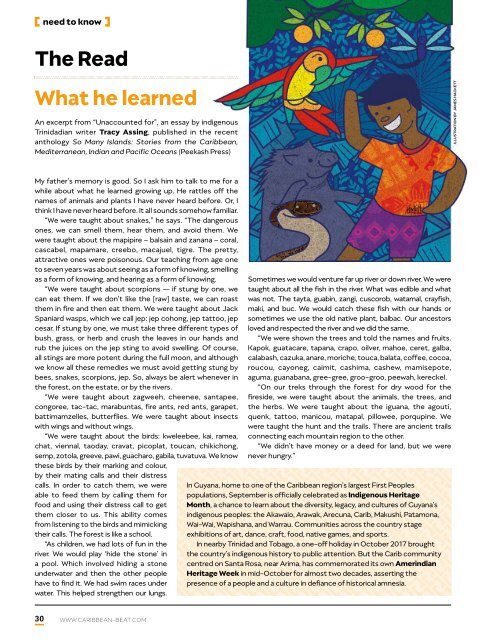Caribbean Beat — September/October 2018 (#153)
A calendar of events; music, film, and book reviews; travel features; people profiles, and much more.
A calendar of events; music, film, and book reviews; travel features; people profiles, and much more.
You also want an ePaper? Increase the reach of your titles
YUMPU automatically turns print PDFs into web optimized ePapers that Google loves.
need to know<br />
The Read<br />
What he learned<br />
An excerpt from “Unaccounted for”, an essay by indigenous<br />
Trinidadian writer Tracy Assing, published in the recent<br />
anthology So Many Islands: Stories from the <strong>Caribbean</strong>,<br />
Mediterranean, Indian and Pacific Oceans (Peekash Press)<br />
Illustration by James hackett<br />
My father’s memory is good. So I ask him to talk to me for a<br />
while about what he learned growing up. He rattles off the<br />
names of animals and plants I have never heard before. Or, I<br />
think I have never heard before. It all sounds somehow familiar.<br />
“We were taught about snakes,” he says. “The dangerous<br />
ones, we can smell them, hear them, and avoid them. We<br />
were taught about the mapipire – balsain and zanana – coral,<br />
cascabel, mapamare, creebo, macajuel, tigre. The pretty,<br />
attractive ones were poisonous. Our teaching from age one<br />
to seven years was about seeing as a form of knowing, smelling<br />
as a form of knowing, and hearing as a form of knowing.<br />
“We were taught about scorpions <strong>—</strong> if stung by one, we<br />
can eat them. If we don’t like the [raw] taste, we can roast<br />
them in fire and then eat them. We were taught about Jack<br />
Spaniard wasps, which we call jep: jep cohong, jep tattoo, jep<br />
cesar. If stung by one, we must take three different types of<br />
bush, grass, or herb and crush the leaves in our hands and<br />
rub the juices on the jep sting to avoid swelling. Of course,<br />
all stings are more potent during the full moon, and although<br />
we know all these remedies we must avoid getting stung by<br />
bees, snakes, scorpions, jep. So, always be alert whenever in<br />
the forest, on the estate, or by the rivers.<br />
“We were taught about zagweeh, cheenee, santapee,<br />
congoree, tac-tac, marabuntas, fire ants, red ants, garapet,<br />
battimamzelles, butterflies. We were taught about insects<br />
with wings and without wings.<br />
“We were taught about the birds: kweleebee, kai, ramea,<br />
chat, viennal, taoday, cravat, picoplat, toucan, chikichong,<br />
semp, zotola, greeve, pawi, guacharo, gabila, tuvatuva. We know<br />
these birds by their marking and colour,<br />
by their mating calls and their distress<br />
calls. In order to catch them, we were<br />
able to feed them by calling them for<br />
food and using their distress call to get<br />
them closer to us. This ability comes<br />
from listening to the birds and mimicking<br />
their calls. The forest is like a school.<br />
“As children, we had lots of fun in the<br />
river. We would play ‘hide the stone’ in<br />
a pool. Which involved hiding a stone<br />
underwater and then the other people<br />
have to find it. We had swim races under<br />
water. This helped strengthen our lungs.<br />
Sometimes we would venture far up river or down river. We were<br />
taught about all the fish in the river. What was edible and what<br />
was not. The tayta, guabin, zangi, cuscorob, watamal, crayfish,<br />
maki, and buc. We would catch these fish with our hands or<br />
sometimes we use the old native plant, balbac. Our ancestors<br />
loved and respected the river and we did the same.<br />
“We were shown the trees and told the names and fruits.<br />
Kapok, guatacare, tapana, crapo, oilver, mahoe, ceret, galba,<br />
calabash, cazuka, anare, moriche, touca, balata, coffee, cocoa,<br />
roucou, cayoneg, caimit, cashima, cashew, mamisepote,<br />
aguma, guanabana, gree-gree, groo-groo, peewah, kereckel.<br />
“On our treks through the forest for dry wood for the<br />
fireside, we were taught about the animals, the trees, and<br />
the herbs. We were taught about the iguana, the agouti,<br />
quenk, tattoo, manicou, matapal, pillowee, porqupine. We<br />
were taught the hunt and the trails. There are ancient trails<br />
connecting each mountain region to the other.<br />
“We didn’t have money or a deed for land, but we were<br />
never hungry.”<br />
In Guyana, home to one of the <strong>Caribbean</strong> region’s largest First Peoples<br />
populations, <strong>September</strong> is officially celebrated as Indigenous Heritage<br />
Month, a chance to learn about the diversity, legacy, and cultures of Guyana’s<br />
indigenous peoples: the Akawaio, Arawak, Arecuna, Carib, Makushi, Patamona,<br />
Wai-Wai, Wapishana, and Warrau. Communities across the country stage<br />
exhibitions of art, dance, craft, food, native games, and sports.<br />
In nearby Trinidad and Tobago, a one-off holiday in <strong>October</strong> 2017 brought<br />
the country’s indigenous history to public attention. But the Carib community<br />
centred on Santa Rosa, near Arima, has commemorated its own Amerindian<br />
Heritage Week in mid-<strong>October</strong> for almost two decades, asserting the<br />
presence of a people and a culture in defiance of historical amnesia.<br />
30<br />
WWW.CARIBBEAN-BEAT.COM


















